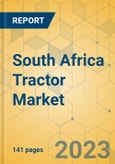Speak directly to the analyst to clarify any post sales queries you may have.
KEY HIGHLIGHTS
- The Limpopo region witnessed a massive increase in farm mechanization in terms of agricultural and industrial productivity.
- The South African tractor market is highly concentrated, with the top players controlling most of the industry. Domestic and global brands, on the other hand, are equally represented in the industry.
- South African government plans schemes and initiatives to facilitate credit and improve agriculture-related operations, which will contribute to the growth of the overall value chain of the industry.
- The South Africa tractor market increased by 20.2% in 2022 from 2021. The increase in crop production and tractor sales was due to favorable climate conditions and government support to farmers.
INSIGHTS BY HORSEPOWER
The 50 HP- 100 HP segment recorded a high industry share in the South Africa tractor market in 2022. The major factor for the steady growth of the medium-power range of tractors is the increased business turnover among hobby and livestock farmers. This segment has more variants than the less than 50 HP segment, yet the usage and capabilities are almost similar. Small and medium-scale farmers using compact tractors are the target consumer base for 50 HP-100 HP tractor manufacturers. The high prevalence of small and medium farmlands in South Africa and country-wide government schemes to enhance farming capabilities boost the country’s 50 HP-100 HP tractor sales.Segmentation by Horsepower
- Less Than 50 HP
- 50 HP-100 HP
- Above 100 HP
INSIGHTS BY DRIVE TYPE
Ease of driving and flexibility with light loads and in plain fields are major factors that boost the demand for two-wheel-drive tractors in the South Africa tractor market. In various farming operations, including small-scale farming, horticulture, orchards, vineyards, and some specialized ones, 2WD tractors are frequently utilized. Small-scale farmers in South Africa frequently favor 2WD tractors because of their accessibility and suitability for smaller landholdings. For small-scale farming operations, they can increase production and efficiency and provide basic functionality.Segmentation by Wheel Drive
- 2-Wheel-Drive
- 4-Wheel-Drive
REGIONAL ANALYSIS
The Limpopo region leads South Africa in adopting and penetrating farm mechanization practices. The South African province of Limpopo’s economy heavily depends on agriculture. Crop farming is one of the many different agricultural pursuits in Limpopo. In the province, maize(corn) is a significant crop grown by commercial and subsistence farmers. In Limpopo, agriculture has a role in economic development, job creation, and food security.Segmentation by Region
- Limpopo
- Eastern Cape
- Gauteng
- Western Cape
- Others
COMPETITIVE LANDSCAPE
John Deere, CNH Industrial, AGCO, and Kubota dominated the South Africa tractor market. These brands have adopted several strategies to gain traction in the industry. These players focus on innovations to compete in the industry. They invest in developing advanced agriculture tractor technology for precision farming, and machine automation has been a focus for these brands. Additionally, there are competent rivals in several of the industry’s sub-segments. Customers become more devoted to established brands as vendors improve their after-sales services.Key Company Profiles
- John Deere
- Kubota
- CNH Industrial
- AGCO
Other Prominent Vendors
- Escorts
- Landini
- Mahindra & Mahindra
- Agrico
- CLAAS
- Deutz-Fahr
- Yanmar
- TAFE
KEY QUESTIONS ANSWERED:
- How big is the South Africa tractor market?
- What is the growth rate of the South Africa tractor market?
- What are the expected units sold in the South Africa tractor market by 2028?
- Which region holds the largest South Africa tractor market share?
- Who are the key companies in the South Africa tractor market?
Table of Contents
Companies Mentioned
- John Deere
- Kubota
- CNH Industrial
- AGCO
- Escorts
- Landini
- Mahindra & Mahindra
- Agrico
- CLAAS
- Deutz-Fahr
- Yanmar
- TAFE
Methodology
Our research comprises a mix of primary and secondary research. The secondary research sources that are typically referred to include, but are not limited to, company websites, annual reports, financial reports, company pipeline charts, broker reports, investor presentations and SEC filings, journals and conferences, internal proprietary databases, news articles, press releases, and webcasts specific to the companies operating in any given market.
Primary research involves email interactions with the industry participants across major geographies. The participants who typically take part in such a process include, but are not limited to, CEOs, VPs, business development managers, market intelligence managers, and national sales managers. We primarily rely on internal research work and internal databases that we have populated over the years. We cross-verify our secondary research findings with the primary respondents participating in the study.

LOADING...
Table Information
| Report Attribute | Details |
|---|---|
| No. of Pages | 141 |
| Published | September 2023 |
| Forecast Period | 2022 - 2028 |
| Estimated Market Value in 2022 | 9181 Units |
| Forecasted Market Value by 2028 | 11150 Units |
| Compound Annual Growth Rate | 3.2% |
| Regions Covered | South Africa |
| No. of Companies Mentioned | 12 |








